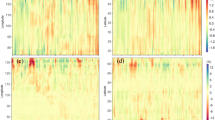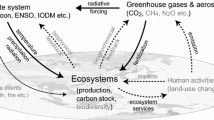Abstract
Ecosystems in China have been absorbing anthropogenic CO2 over the last three decades. Here, we assess future carbon uptake in China using models from phase 5 of Coupled Model Intercomparison Project under four socio-economic scenarios. The average of China’s carbon sink from 2006 to 2100 represented by multimodel mean net ecosystem production (NEP) is projected to increase (relative to averaged NEP from 1976 to 2005) in the range of 0.137 and 0.891 PgC a−1 across different scenarios. Increases in NEP are driven by increases in net primary production exceeding increases in heterotrophic respiration, and future carbon sink is mainly attributed to areas located in eastern China. However, there exists a considerable model spread in the magnitude of carbon sink and model spread tends to be larger when future climate change becomes more intense. The model spread may result from intermodel discrepancy in the magnitude of CO2 fertilization effect on photosynthesis, soil carbon turnover time, presence of carbon-nitrogen cycle and interpretation of land-use changes. For better quantifying future carbon cycle, a research priority toward improving model representation of these processes is recommended.





Similar content being viewed by others
References
Fang JY, Chen AP, Peng CH et al (2001) Changes in forest biomass carbon storage in China between 1949 and 1998. Science 292:2320–2322
Fang J, Guo Z, Hu H et al (2014) Forest biomass carbon sinks in East Asia, with special reference to the relative contributions of forest expansion and forest regrowth. Glob Change Biol. doi:10.1111/gcb.12512
Piao SL, Fang JY, Zhou LM et al (2005) Changes in vegetation net primary productivity from 1982 to 1999 in China. Glob Biogeochem Cycles 19:GB2027
Piao SL, Fang JY, Ciais P et al (2009) The carbon balance of terrestrial ecosystems in China. Nature 458:1009–1013
IPCC (2013) Summary for policymakers. In: Stocker TF, Qin D, Plattner GK, et al (eds) Climate change 2013: the physical science basis. Contribution of working group I to the fifth assessment report of the intergovernmental panel on climate change. Cambridge University Press, Cambridge
Luo YQ, Weng ES (2011) Dynamic disequilibrium of terrestrial carbon cycle under global change. Trends Ecol Evol 26:96–104
Sitch S, Friedlingstein P, Gruber N et al (2013) Trends and drivers of regional sources and sinks of carbon dioxide over the past two decades. Biogeosci Discuss 10:20113–20177
Piao SL, Ito A, Li SG et al (2012) The carbon budget of terrestrial ecosystems in East Asia over the last two decades. Biogeosciences 9:3571–3586
Taylor KE, Stouffer RJ, Meehl GA (2012) An overview of CMIP5 and the experiment design. Bull Am Meteorol Soc 93:485–498
Falloon P, Jones CD, Ades M et al (2011) Direct soil moisture controls of future global soil carbon changes: an important source of uncertainty. Glob Biogeochem Cycle 25:GB3010
Booth BBB, Jones C, Collins M et al (2012) High sensitivity of future global warming to land carbon cycle processes. Environ Res Lett. doi:10.1088/1748-9326/7/2/024002
Higgins PAT, Harte J (2012) Carbon cycle uncertainty increases climate change risks and mitigation challenges. J Clim 25:7660–7668
Shao P, Zeng X, Sakaguchi K et al (2013) Terrestrial carbon cycle: climate relations in Eight CMIP5 Earth system models. J Clim 26:8744–8764
Gregory JM, Jones CD, Cadule P et al (2009) Quantifying carbon cycle feedbacks. J Clim 22:5232–5250
Huntingford C, Lowe JA, Booth BBB et al (2009) Contributions of carbon cycle uncertainty to future climate projection spread. Tellus B 61:355–360
Boden TA, Marland G, Andres RJ (2013) Global, regional, and national fossil-fuel CO2 emissions. Carbon Dioxide Information Analysis Center, Oak Ridge National Laboratory, US Department of Energy, Oak Ridge, TN. doi:10.3334/CDIAC/00001_V2013
Friend AD, Lucht W, Rademacher TT et al (2014) Carbon residence time dominates uncertainty in terrestrial vegetation responses to future climate and atmospheric CO2. Proc Natl Acad Sci USA 111:3280–3285
Roy T, Bopp L, Gehlen M et al (2011) Regional impacts of climate change and atmospheric CO2 on future ocean carbon uptake: a multimodel linear feedback analysis. J Clim 24:2300–2318
Ciais P, Sabine C, Bala G et al (2013) Carbon and other biogeochemical cycles. In: Stocker TF, Qin D, Plattner G-K et al (eds) Climate change 2013: the physical science basis. Contribution of working group I to the fifth assessment report of the intergovernmental panel on climate change. Cambridge University Press, Cambridge
Matthews HD, Weaver AJ, Meissner KJ (2005) Terrestrial carbon cycle dynamics under recent and future climate change. J Clim 18:1609–1628
Fisher JB, Sikka M, Sitch S et al (2013) African tropical rainforest net carbon dioxide fluxes in the twentieth century. Philos Trans R Soc B 368:20120376
Todd-Brown KEO, Randerson JT, Post WM et al (2013) Causes of variation in soil carbon simulations from CMIP5 Earth system models and comparison with observations. Biogeosciences 10:1717–1736
Friedlingstein P, Fung IY, Holland EA et al (1995) On the contribution of CO2 fertilization to the missing biospheric sink. Glob Biogeochem Cycles 9:541–556
Thompson MV, Randerson JT, Malmström CM et al (1996) Change in net primary production and heterotrophic respiration: how much is necessary to sustain the terrestrial carbon sink? Glob Biogeochem Cycles 10:711–726
Friedlingstein P, Meinshausen M, Arora VK et al (2014) Uncertainties in CMIP5 climate projections due to carbon cycle feedbacks. J Clim 27:511–526
Bonan GB, Hartman MD, Parton WJ et al (2013) Evaluating litter decomposition in earth system models with long-term litterbag experiments: an example using the community land model version 4 (CLM4). Glob Change Biol 19:957–974
Anav A, Friedlingstein P, Kidston M et al (2013) Evaluating the land and ocean components of the global carbon cycle in the CMIP5 earth system models. J Clim 26:6801–6843
Keppel-Aleks G, Randerson JT, Lindsay K et al (2013) Atmospheric carbon dioxide variability in the community earth system model: evaluation and transient dynamics during the twentieth and twenty-first centuries. J Clim 26:4447–4475
Zaehle S, Friedlingstein P, Friend AD (2010) Terrestrial nitrogen feedbacks may accelerate future climate change. Geophys Res Lett 37:L01401
Piao S, Sitch S, Ciais P et al (2013) Evaluation of terrestrial carbon cycle models for their response to climate variability and to CO2 trends. Glob Change Biol 19:2117–2132
Brovkin V, Boysen L, Arora K (2013) Effect of anthropogenic land-use and land-cover changes on climate and land carbon storage in CMIP5 projections for the twenty-first century. J Clim 26:6859–6881
Jones AD, Collins WD, Edmonds J et al (2013) Greenhouse gas policy influences climate via direct effects of land-use change. J Clim 26:3657–3670
Penuelas J, Poulter B, Sardans J et al (2013) Human-induced nitrogen-phosphorus imbalances alter natural and managed ecosystems across the globe. Nat Commun. doi:10.1038/ncomms3934
Koven CD, Ringeval B, Friedlingstein P et al (2011) Permafrost carbon-climate feedbacks accelerate global warming. Proc Natl Acad Sci USA 108:14769–14774
Zaehle S, Dalmonech D (2011) Carbon-nitrogen interactions on land at global scales: current understanding in modelling climate biosphere feedbacks. Curr Opin Environ Sustain 3:311–320
Zaehle S, Medlyn BE, De Kauwe MG et al (2014) Evaluation of 11 terrestrial carbon–nitrogen cycle models against observations from two temperate free-air CO2 enrichment studies. New Phytol. doi:10.1111/nph.12697
Xu B, Guo ZD, Piao SL et al (2010) Biomass carbon stocks in China’s forests between 2000 and 2050: a prediction based on forest biomass-age relationships. Sci China-Life Sci 53:776–783
Acknowledgments
This work was supported by Chinese Ministry of Environmental Protection Grant (201209031), the National Natural Science Foundation of China (31321061).
Conflict of interest
The authors declare that they have no conflict of interest.
Author information
Authors and Affiliations
Corresponding author
Additional information
SPECIAL TOPIC: Impacts of Climate Change on Biodiversity
Electronic supplementary material
Below is the link to the electronic supplementary material.
About this article
Cite this article
Wang, T., Lin, X., Peng, S. et al. Multimodel projections and uncertainties of net ecosystem production in China over the twenty-first century. Chin. Sci. Bull. 59, 4681–4691 (2014). https://doi.org/10.1007/s11434-014-0613-y
Received:
Accepted:
Published:
Issue Date:
DOI: https://doi.org/10.1007/s11434-014-0613-y




